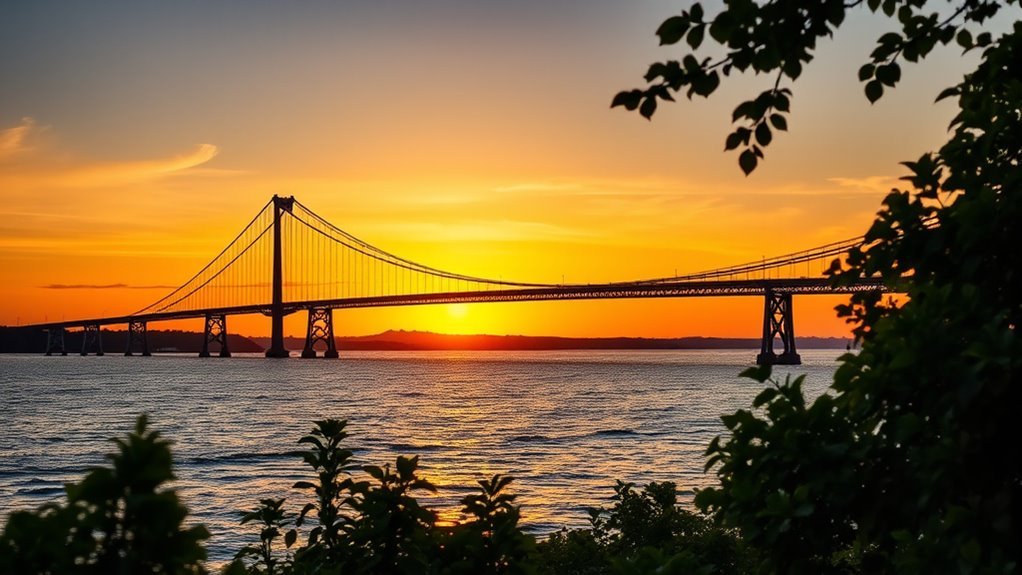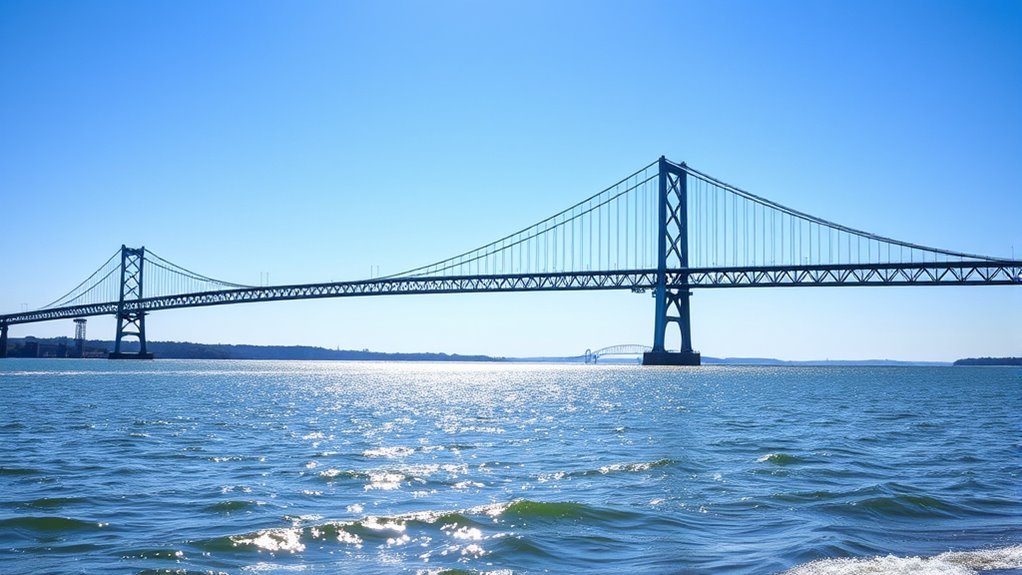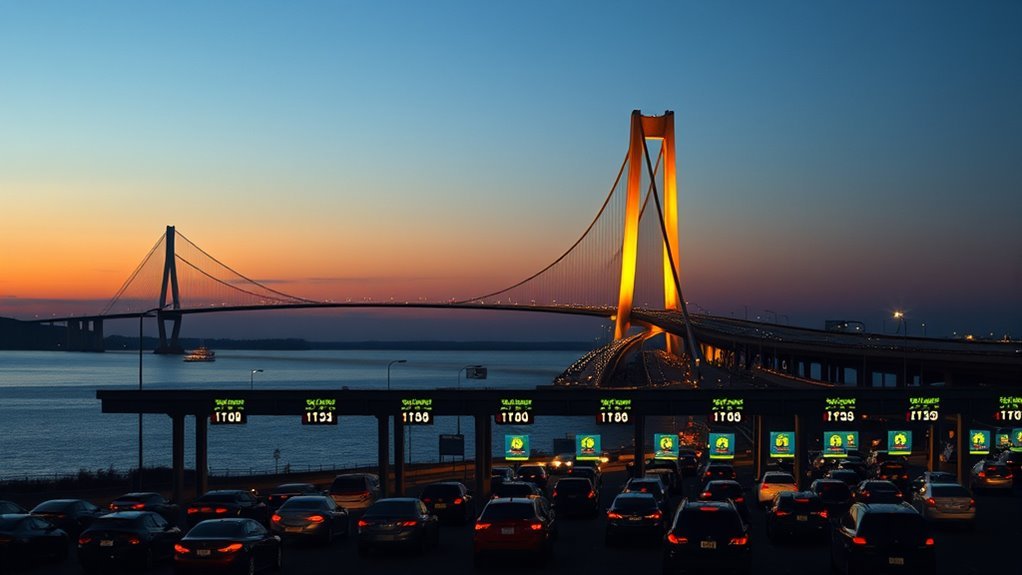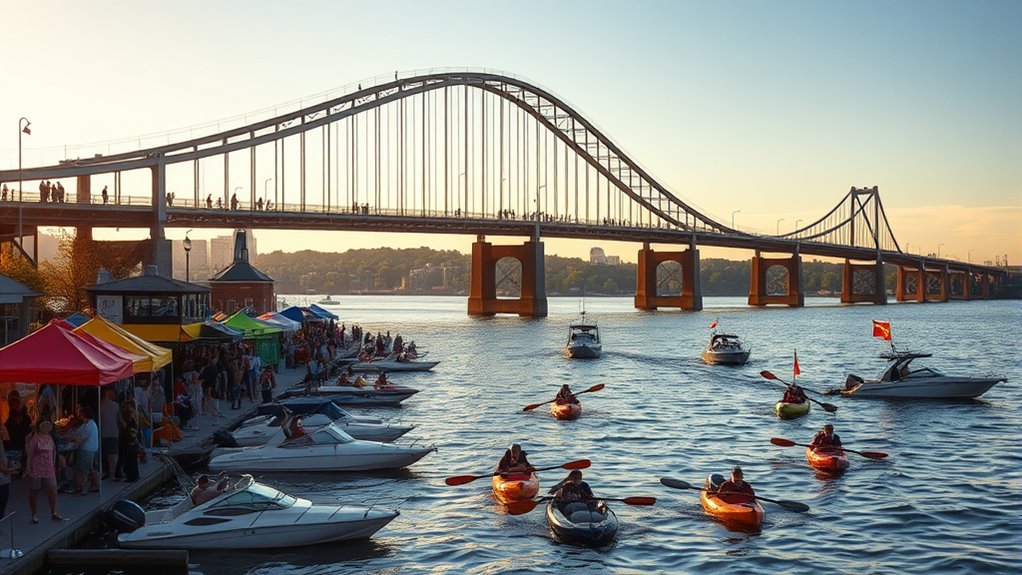You’re driving across the Chesapeake Bay Bridge, a marvel of engineering that connects Maryland’s eastern and western shores. This crucial link, stretching over 21,000 feet, opened in 1952 and remains essential for regional commerce and daily commutes. With an average of 61,000 vehicles crossing each day, ongoing maintenance projects keep it in top shape. Ever wondered about the challenges and triumphs behind its construction? There’s more to discover about this iconic structure.
Key Takeaways
- The Chesapeake Bay Bridge connects Maryland’s eastern and western shores, reducing traffic congestion on U.S. Route 50 and U.S. Route 301.
- Opened in 1952, it’s a critical transportation infrastructure, with a second span added in 1973 for increased capacity.
- The bridge spans over 21,000 feet and accommodates five lanes, with traffic patterns managed by overhead signals.
- $3.8 billion is needed for maintenance, with strategic planning essential for future upkeep and structural integrity.
- A major re-decking project for the eastbound span is underway and is expected to be completed by May 2025.
Historical Background

Although the idea of bridging the Chesapeake Bay dates back to 1907, construction finally began in January 1949, following World War II.
The Chesapeake Bay Bridge, officially known as the Gov. William Preston Lane Jr. Memorial Bridge, opened on July 30, 1952. At that time, it was the longest continuous over-water steel structure, providing an essential transportation link across the bay.
Serving as part of U.S. Route 50 and US 301, the bridge quickly became critical for reducing traffic congestion and connecting Maryland’s eastern and western shores to coastal areas.
Construction Milestones
The Chesapeake Bay Bridge’s construction marked several significant milestones that transformed Maryland’s transportation landscape.
The original span opened on July 30, 1952, following a groundbreaking ceremony in January 1949, which World War II delayed. This achievement laid the groundwork for future expansions.
On June 28, 1973, a new parallel span was added, greatly increasing capacity and easing traffic between Maryland’s Eastern and Western Shores.
The Maryland Transportation Authority (MDTA) played an essential role in managing these projects. In 1967, the bridge was dedicated to Governor William Preston Lane Jr., in recognition of his pivotal role in its development.
Presently, the MDTA is overseeing a major re-decking of the eastbound span, ensuring the bridge meets modern demands and continues to serve efficiently.
Bridge Specifications

Spanning an impressive length, the Chesapeake Bay Bridge stands as Maryland’s longest fixed water crossing.
The bridge specifications reveal a total span of 21,273 feet for the eastbound lane and 21,047 feet for the westbound lane. The Maryland Transportation Authority (MDTA) oversees this critical infrastructure, which includes an eastbound cantilever and a westbound continuous truss design.
Both spans feature suspension bridge elements, ensuring stability and strength through their steel superstructure. At its peak, the eastbound span reaches a height of 354 feet, while the westbound span rises to 379 feet.
With widths of 28 feet eastbound and 38 feet westbound, the bridge accommodates five lanes of traffic. These specifications highlight the engineering marvel under MDTA’s careful management.
Traffic Management
When you travel across the Chesapeake Bay Bridge, you’ll notice the sophisticated traffic management system that keeps vehicles moving smoothly.
The bridge features five lanes with adjustable traffic patterns, managed by overhead lane control signals. This setup optimizes flow during peak travel times and incidents, ensuring efficient two-way traffic management.
On average, approximately 61,000 vehicles pass through daily, with even higher numbers during weekends and holidays, especially in the summer.
The south-most span typically handles eastbound traffic, while the north-most span handles westbound traffic. Tolls are collected only in the eastbound direction, but with all-electronic tolling, you won’t need to stop.
Weather conditions are closely monitored to adjust traffic patterns as needed, ensuring a safe journey across the bridge.
Toll System

While maneuvering through the sophisticated traffic management of the Chesapeake Bay Bridge, you’ll encounter its efficient toll system designed to streamline your crossing experience.
The Maryland Transportation Authority (MDTA) oversees this one-way toll system, which charges only eastbound travelers. Since April 1989, tolls have applied exclusively in this direction, ensuring smooth travel westbound.
On May 12, 2020, all-electronic tolling was implemented, eliminating the need for cash transactions. You’ll either use E-ZPass or Video Tolling, making the process hassle-free.
Standard fees are $6.00 for two-axle vehicles, but Maryland E-ZPass holders enjoy a discounted rate of $2.50. With daily traffic averaging around 61,000 cars, this system not only facilitates movement but also generates revenue essential for maintaining the bridge.
Larger vehicles and motorcycles pay specific toll rates.
Notable Incidents
Despite its impressive engineering, the Chesapeake Bay Bridge has faced its share of notable incidents that have impacted both its reputation and safety measures. The bridge closed four times due to inclement weather, highlighting concerns about traveler safety.
Key incidents include:
- Tractor-trailer fall (2008): This shocking event spurred investigations into safety and structural integrity.
- Suicides: Over 75 reported suicides have led to increased safety measures and awareness campaigns.
- Vehicle crashes: A 2017 truck crash and a 2020 dairy truck incident are among the 16 crashes recorded running off the bridge.
- Corrosion issues: Post-incident inspections revealed corrosion of the steel reinforcements, emphasizing the need for ongoing maintenance.
These incidents underline the importance of continuous safety evaluations and improvements.
Community Events

You can’t miss the Bay Bridge Walk tradition, a community event that brings over 20,000 participants together each year to celebrate this iconic structure.
These events greatly boost the local economy by attracting tourists and supporting local businesses.
Bay Bridge Walk Tradition
Every first Sunday in May, the Chesapeake Bay Bridge transforms from a bustling roadway into a pedestrian paradise as thousands gather for the annual Bay Bridge Walk.
Embrace this cherished tradition, which began in 1975, as you connect with the Eastern Shore community and experience the bridge’s grandeur from a new perspective.
Here’s why you should join:
- Unparalleled Views: Walkers enjoy stunning vistas of the Chesapeake Bay, creating unforgettable memories.
- Community Spirit: Meet fellow participants and celebrate a shared sense of camaraderie.
- Historic Tradition: Participate in an event that has stood the test of time, despite occasional cancellations.
- Fresh Air and Exercise: Benefit from an invigorating walk in an extraordinary setting.
This event promises a unique blend of nature, tradition, and community.
Impact on Local Economy
As you take part in the Bay Bridge Walk, you’re not just enjoying breathtaking views and fresh air—you’re also contributing to the local economy.
Events like the Bay Bridge Walk and Run attract tourists to the Chesapeake’s Eastern Shore, fostering economic growth by increasing local business revenues. When visitors flock here, they fill restaurants, shops, and hotels, providing a crucial influx of cash.
The bridge’s average daily traffic of 61,000 vehicles highlights its importance in supporting these businesses, especially during peak seasons. Increased property values and development opportunities have transformed surrounding areas into thriving bedroom communities for Baltimore and D.C.
Besides, toll revenue aids local infrastructure improvements, ensuring sustained economic development. Your participation directly supports this vibrant economic ecosystem.
Future Developments
Amid ongoing discussions, the future of the Chesapeake Bay Bridge is poised for transformative developments to address the looming surge in traffic.
The Maryland Transportation Authority (MDTA) is considering building a new bridge to replace the aging structure. They aim to finance the construction of two new bridges with six to ten lanes, including dedicated lanes for buses and pedestrians. The estimated costs range from $7.3 billion to $8.4 billion, indicating the significant investment required.
Here’s what you need to know:
- New bridge: A fresh structure to accommodate future traffic.
- Financing: MDTA’s challenge to secure billions.
- Current maintenance: $3.8 billion needed through 2065.
- Ongoing projects: Eastbound deck replacement is scheduled to continue until May 2025.
These developments underscore the importance of planning for the bridge’s future.
Conclusion
You’ve journeyed through the history and significance of the Chesapeake Bay Bridge. As you envision its towering cantilever and truss designs, remember the bridge’s essential role in Maryland’s connectivity and economy. With daily traffic management challenges and the ongoing deck replacement project, it’s clear there’s no slowing down. Anticipate future developments that will enhance its efficiency and safety. Whether you’re crossing for work or leisure, the bridge remains a pivotal part of your travels and community.
FAQs
1. How Long Is the Bridge at Chesapeake Bay?
You’re inquiring about the total length of a bridge. It’s notable for its substantial span, with the eastbound at 21,273 feet and the westbound at 21,047 feet. Together, they support a significant volume of daily vehicle traffic.
2. How Many Underwater Tunnels Are on the Chesapeake Bay Bridge?
You might think you’re asking about underwater tunnels on the Chesapeake Bay Bridge, but it doesn’t have any. It’s the Chesapeake Bay Bridge-Tunnel that features two underwater tunnels, connecting the Delmarva Peninsula to Hampton Roads.
3. How Long Does It Take to Drive Across the Chesapeake Bay Bridge?
Driving across takes about 10 to 15 minutes. You’ll experience a smooth journey unless there’s heavy traffic or bad weather. Keep the speed limit in mind, and plan for potential delays during weekends or peak travel times.
4. What Is the Fear of Driving Over the Chesapeake Bay Bridge?
You fear driving over high bridges due to their height, narrow lanes, and potential for strong winds. Anxiety increases with past accidents and suicides, making each crossing a challenge. Safety concerns linger in your mind as you drive.
